Leading by example: The restaurants and cafes shining a sustainable light
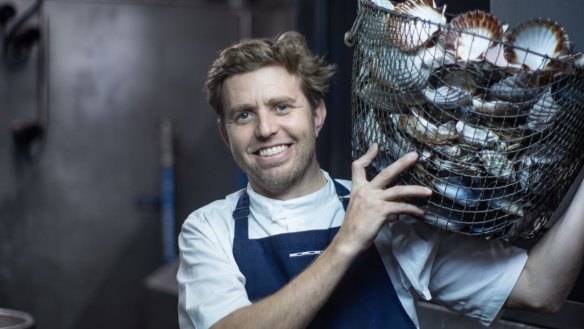
Who do you turn to when you want to create a sustainable kitchen? We already look to chefs for food inspiration. Now, as more restaurants put sustainability at the heart of what they do, home cooks can look at the food world for ideas and action plans for creating change at home.
Today, Good Food shines a light on innovators who place as much emphasis on caring for the environment as they do on fine flavours and pretty plating.
Stokehouse, Melbourne
A seaside new build
Restaurateur Frank van Haandel was devastated when Stokehouse burned down in 2014. "But there was an opportunity created out of adversity," he says. Van Haandel committed to doing a green rebuild, prompted initially by the iconic restaurant's seaside location. "With climate change and rising oceans, the first thing we decided was to build 900mm higher."
Used oyster shells are collected by an organisation that sprinkles them into the sea to recreate reefs damaged by commercial fishing.
Sustainability is integral to every aspect of the restaurant, from the build to daily operations. Used oyster shells are collected by an organisation that sprinkles them into the sea to recreate reefs damaged by commercial fishing. Food waste is tipped into a big smelly, sloshy tank that uses the same digestion principles as our own bodies to turn plate scrapings into a liquid that can safely be flushed into sewage.
Rather than endless use of soap and cleaning chemicals in the kitchen, Stokehouse has e-water, a remarkable system that uses an electrical charge to turn water and salt into a disinfectant that comes out of taps just like normal water. When you start washing your hands, the e-water feels normal, then it transitions to feeling oily as the chemical structure of the water changes. Hey presto, clean hands.
Geothermal heating and cooling is perhaps the most extraordinary aspect of the new Stokehouse. A continuous length of copper piping runs 80 metres into the sand, soil and rock below, does a U-turn, comes back up and repeats that journey 39 times. The system is a heat exchange that makes use of the consistent 17C-18C temperature of the earth to run the building's heating, cooling and hot water.
Van Haandel estimates building sustainably cost him an extra $2 million "and thousands of hours", but hopes that investment will be repaid in 10 years, perhaps less given the increase in conventional energy prices. "Gas and electricity are commodities I was trying to minimise and we all know what's happening with costs there," he says. Stokehouse has been awarded five stars by the Green Building Council of Australia, the only Victorian fine-dining restaurant to have them. (In Sydney, Barangaroo South Precinct has five stars too.)
In the kitchen, executive chef Jason Staudt visits suppliers before committing to their produce and makes the most of every ingredient, sometimes by using part of it at Stokehouse and the rest at casual downstairs diner Pontoon. Scraps are repurposed: potato skin is used for an elaborate jacket potato filled with beef tartare (made from beef trim) and topped with caviar.
Other changes are about unpicking ingrained habits. In cooking school, chefs are often taught to roll seafood mousse in cling film to form a neat sausage shape. But what do you do in a kitchen that strives to minimise plastic? "We ask, do you need that seafood sausage to be a perfect circle?" asks Staudt. "Could you press it and cut it, or just have a more natural shape? It's about thinking differently."
Change inspires change. Stokehouse aims to return packaging upon delivery. "We receive goods in our loading bay, unpack them there and then give the crate back to the supplier," says Staudt. "It makes everyone you're encountering more accountable. We also email suppliers and ask them to use less plastic and polystyrene. If they hear it enough, they'll change the industry."
How to apply at home We don't all have the opportunity (and anguish) of starting from scratch but Frank van Haandel believes everyone can be more environmentally conscious. Stokehouse's shade screens are made from Accoya, a durable modified wood sourced from fast-growing renewable forests. It's suitable for windows, doors, cladding and decking too. "It's non-toxic and will stand up to harsh ocean air for 40 years plus," says Van Haandel.
Stokehouse, 30 Jacka Blvd, St Kilda, 03 9525 5555, stokehouse.com.au
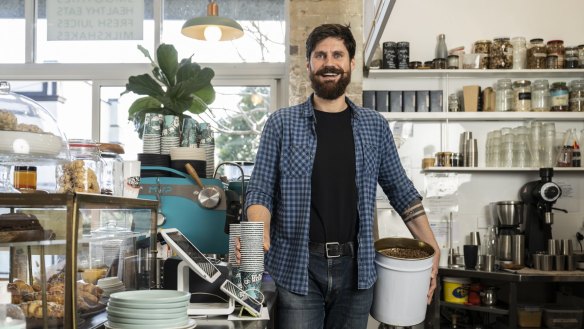
Cat & Cow Coffee, Sydney
A Zero Waste Cafe
If you take a late afternoon wander out the back of a run-of-the-mill cafe, you'll see full bins, polystyrene crates and a jumble of cardboard boxes. But not at Cat and Cow in Randwick. "At the end of the week, our landfill bin is just one-tenth full," says Lenka Kriz, who owns the Sydney cafe with husband Jakub. "It would only have stuff like broken glass in it."
Zero waste is the target. They compost or recycle almost everything. Coffee grounds, food waste, soiled napkins, compostable coffee cups and lids are all placed in an organic bin which is picked up by a trusted waste recycler. Simple wins have included cleaning fridge filters, which caused a dramatic reduction in power use.
Avoiding single-use is the ultimate aim. They encourage customers to sit down for coffee, swap-and-go from a mug library or use a KeepCup. Those who insist on a single-use cup pay 50c extra for BioPak compostable cups and the money is donated to ocean clean-up. BioPak's 280ml cups are $111.40 per 1000, compared to around $70 for 1000 standard cups.
The Krizes waste-wise journey began at home and has translated to their business. "We couldn't go against our values," says Lenka Kriz. "People told us it would be harder, more expensive but we knew that doing something we didn't believe in would burn us down."
How to apply "If I don't have time to sit down for a coffee and I didn't bring my KeepCup then I don't have a coffee," says Lenka Kriz. "Sometimes convenience isn't necessary." Beyond compostable, look out for Good Edi cups, which are edible, break down in compost within two weeks and are used in 50 cafes nationally.
Cat & Cow Coffee, 49 Clovelly Road, Randwick, catandcow.coffee
Little Sky, Melbourne
Sustainable ice-cream
It only takes one taste test of Little Sky's gelato to realise that things are done differently here. It's not the ice-cream (though that's good too), it's that the tasting spoon is a humble, washable metal teaspoon, rather than the plastic utensil used in most places. "Convenience is king but it's wasteful too," says owner Max Shatkhin.
Shatkhin takes sustainability so seriously that he has undertaken the rigorous process of becoming B Corp-certified. His Brighton store is the only gelato shop in Australia and one of just 400 or so businesses nationwide that have assessed their social and environmental impact through the internationally recognised agency. A score of 80 is necessary for certification; Little Sky smashed it with 90.7.
Shatkhin uses only green power. He sells his ice-cream in compostable containers and has about 500 stainless steel canisters in circulation among his customers. "There's a $6 deposit, people take it home and when it's empty they bring the container back and we refill it," he says. In the kitchen, he buys "ugly" fruit to make his sorbets and gelati. "Berries, bananas and apples are often rejected because they're too small or too big," he says. "There's nothing wrong with them. It saves us money and stops produce going to landfill."
The wider impacts are considered too. "We work with our suppliers to minimise delivery runs to reduce the carbon footprint of their vans," says Shatkhin. "Quite often businesses order a small amount each day and suppliers deliver five times a week. I try to bulk order." Some eco-solutions are more expensive, some just require tenacity. "We cryovac everything in bulk," says Shatkhin. "Traditionally those bags are single-use plastic. I spent a month trying to find compostable bags and every business laughed in my face. But eventually I found a company in Japan that is making them. There is always an option if you persevere."
How to apply "Buy wonky fruit, buy green power, compost at home or use council green bins," says Shatkhin. And have conversations. "If you get takeaway, ask if you can bring a Tupperware or Pyrex container from home. It requires a bit of extra effort but if you're committed to it it's not that hard."
Little Sky, 332 Bay Street, Brighton, littleskygelato.com.au
Riso, Melbourne
Thoughtful local dining
After a career in fine dining restaurants followed by a stint in a social enterprise cafe, chef Paolo Arlotta was reluctant to open his own restaurant, simply because of the waste and emissions hospitality businesses can generate.
Deciding to proceed with his Fitzroy diner Riso meant building sustainability into every fibre of its being. The menu is vegetarian, mostly to reduce carbon impacts. "I am more for sustainable eating than vegetarian per se," says Arlotta. "I respect someone that eats organic meat more than someone who buys thoughtlessly from a supermarket."
Most produce is sourced from local farms but there are some specialty rices that Arlotta imports from Italy. He works with an environmental consultancy to calculate emissions related to importing and offsets them by paying for trees to be planted in the Daintree Rainforest. "The dream is to take the staff there and plant together," says Arlotta.
Food waste is minimised through thoughtful cooking. "Scraps and trim are used in a broth, we ferment pumpkin 'guts' and make a powder to sprinkle on risotto and leftover rice is used for arancini. The small amount of food waste is collected by a commercial waste business and turned into organic compost.
How to apply Save vegetable peelings and trimmings in the freezer and when you have a handful use them to make a stock. Add to a large pot of water with a few peppercorns and a bay leaf and bring to a simmer for 40 minutes or so. Strain, season and use as a soup base or risotto liquid.
Riso Diner, 60 Rose Street, Fitzroy, 0450 700 394, risodiner.com
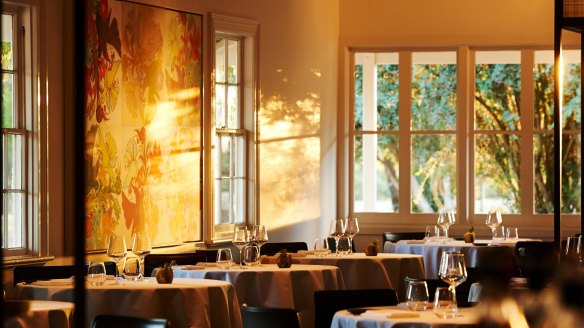
Brae
Farm fine dining
Leading regional restaurant Brae is also a working regenerative farm which grows 90 percent of the fruit and vegetables used in the restaurant. Food waste from the restaurant is composted and used to feed the soil in a nourishing closed loop. Even grain for the house sourdough is grown, harvested and milled on the Birregurra property. Brae generates solar power (17 megawatt hours per month, offsetting 1.34 tonnes of carbon) and collects water in tanks with an overall capacity of 160,000 litres. Waste water is processed on site and used for irrigation.
"We don't like to be preachy," says co-owner Julianne Bagnato. "The property speaks for itself. By wandering around, having that immersion experience, people can see the produce growing and see our overall philosophy made up of many small actions."
How to apply We aren't all going to grow and mill our own grain but many of us would be able to grow a lettuce or two in a pot or garden bed. Transition Farm sells Tom Thumb lettuce seeds which grow to mature plants in just 35 days. It's $4.95 for 250 seeds.
Brae, 4285 Cape Otway Road, Birregurra, 03 5236 2226, braerestaurant
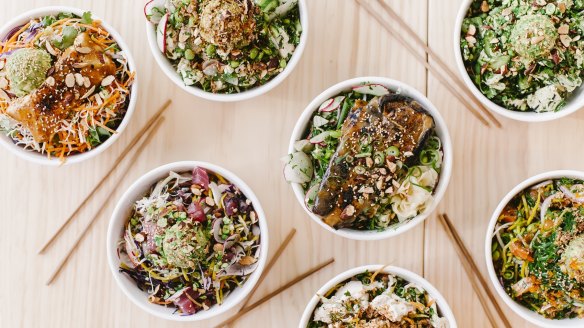
Fishbowl, national
Eco-sourcing at scale
Quick service restaurant Fishbowl has 30 outlets in Victoria, NSW and Queensland turning out healthy bowls with Japanese flavours. Farmed Tasmanian Atlantic salmon has been a key ingredient in dishes like the Mr X with sashimi, shallots and roasted sesame dressing. But founders Nic Pestalozzi and Nathan Dalah started to feel uncomfortable using a product gaining attention for its questionable environmental practices.
They've just switched to ocean-farmed king salmon from New Zealand, which has been certified for its best-practice aquaculture. "There are no antibiotics, the fish have more space and there are stricter regulations," says Pestalozzi of the move that will cost them $1 million a year. "People might think what we are doing is ridiculous because it's so much more expensive, but we want to lead with what we think is right. A sustainable business is a good business. It's a long-term way of thinking."
How to apply When considering which fish to buy, seafood expert John Susman encourages consumers to head towards the bottom of the food chain. "Look for high breeding rates and short life cycles: sardines, blue mackerel, squid and grenadier, for example," he says. Home cooks should use more parts of the fish too. "Fish wings are great snacks, heads and frames can be used for stocks, belly for sashimi or poke and the classic centre cut for Saturday night," he says.
Fishbowl, multiple outlets, fishbowl.com.au
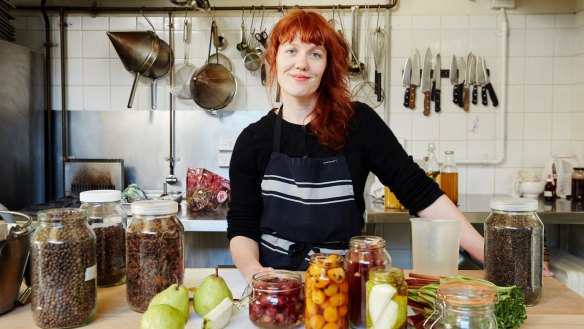
Cornersmith
Bringing people along
For a decade, Alex Elliott-Howery has been a leading voice in environmental food practices through her Sydney cafe and cooking school Cornersmith. The emphasis has changed of late. "Early on, it was about seasonal and local, about knowing where food comes from, then it was about preservation and those lost skills," she says.
Now her focus is more on food waste. "Tiny things can make people feel empowered," she says. "We will have celery leaves on a salad in the cafe and we'll use them to make a pesto in a cooking class: people eat them, realise they're delicious and now they know they can eat celery leaves." Leeks are another one. "We've been taught to chop the tops off and throw them away," she says. "But you can saute them low and slow with butter and garlic and use them as a sauteed green." The win is in less waste but also cost. "You are getting two things out of one."
Bringing people along is the aim. "Life is tough already," she says. "I don't want to tut-tut anyone. It's gentle activism that gets people thinking."
How to apply After chatting to Alex, I made a leek-and-celeriac soup and sauteed the green leek tops in olive oil and cumin then used them as a soup topping. I will never throw leek tops away again!
88 View Street, Annandale, 02 9660 4346, cornersmith.com.au
Restaurant reviews, news and the hottest openings served to your inbox.
Sign up